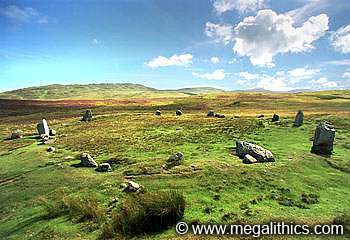
 |
Photo Gallery |
|
Panoramas |
||
Infrared |
||
| SH 72292 74658 (GPS 38min) | Diameter 24m x 24.8m (Meas.) |
| Visited August 2001 | No magnetic anomalies. |
A large, open circle with a double
portalled entrance at the SW, this ring strongly reminded us of Lakeland circles
such as Swinside. We counted
29 stones in the circle, with thirteen of them still standing. The stones had
been erected in a substantial bank of rubble, this embankment gives the circle
interior a dish-like appearance from some angles. The tallest stones stand at
the NW, E and W, all of these are about 1.7m tall, and two of them have sinister
legends associated with them. The Stone of Sacrifice stands at the east,
this stone has a curved natural ledge at the top of its outer face, legend has
it that the bodies of infants, sacrificed during ceremonies within the ring,
were placed here. At the west stands the Deity Stone, this stone has a strangely
anthropomorphic appearance, resembling a hooded human figure, its
"head" seems to look straight at the circle centre. According to
legend, this stone will strike down anyone who swears near to it. A sceptic is
said to have tested the claim by going to the circle at night swearing and
blaspheming, his corpse was found the next day lying at the foot of the Deity Stone.
You have been warned!
Although the portal stones have fallen and the northern inner stone is missing,
the entrance is still pretty evident today. The southern pair of portal stones are said to be aligned on the major
southern moonset when viewed from the centre of the circle. This astronomical
alignment of portal stones is another feature shared with the large open circles
of the Lake District.
The circle was
excavated in 1958, yielding several finds. Non-local quartz was found scattered
in the circle and a central mass of local stone covered two cremations. Both of
the cremations were those of children, one of which was found in a small cist
covered by an enlarged Early Bronze Age food vessel. Other finds included a
second food vessel, three whetstones and a small bronze knife.
The many Late Neolithic features of the circle and its proximity to the Graig Lwyd axe
factory, only a quarter of a mile away, suggest an early date for its
construction, which is somewhat at odds with the Bronze Age material found
within it. The Bronze Age burials and deposits are thought to indicate secondary usage of the circle, a reuse of an earlier
monument in the rituals of a later age.
There are several other megalithic monuments on Penmaenmawr, "The great
stone headland", the remains of Redfarm,
Circle 275 and Circle
278 all lie very close to the Druid's Circle.